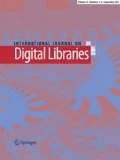Abstract
Concept browsing interfaces can help educators and learners to locate and use learning resources that are aligned with recognized learning goals. The Strand Map Service enables users to navigate interactive visualizations of related learning goals and to request digital library resources aligned with learning goals. These interfaces are created using a programmatic Web service interface that dynamically generates interactive visual components. Preliminary findings suggest that these library interfaces appear to help users stay focused on the scientific content of their information discovery task, as opposed to focusing on the mechanics of searching.
Similar content being viewed by others
References
American Association for the Advancement of Science (1993) Benchmarks for Science Literacy, Project 2061. Oxford University Press
National Research Council (1999) Transforming undergraduate education in science, mathematics, engineering, and technology education. National Academy Press, Washington, DC
National Research Council (1996) National Science Education Standards. National Academy Press, Washington, DC
Wattenberg F (1998) A national digital library for science, mathematics, engineering, and technology education. D-Lib Mag 5. Arlington, VA. http://www.dlib.org/dlib/october98/wattenberg/10wattenberg.html#contents
Zia LL (2001) The NSF National Science, Technology, Engineering, and Mathematics Education Digital Library (NSDL) program: new projects and a progress report. D-Lib Mag 7
Hall RH, Hall MA, Saling CB (1999) The effects of graphical postorganization strategies on learning from knowledge maps. J Exp Educat 67:101–112
O’Donnell AM, Dansereau DF, Hall RH (2002) Knowledge maps as scaffolds for cognitive processing. Educat Psychol Rev 14:71–86
American Association for the Advancement of Science, National Science Teachers Association (2001) Atlas of Science Literacy. Project 2061. Washington, DC
Sumner TR, Bhushan S, Ahmad F, Gu Q (2003) Designing a language for creating conceptual browsing interfaces for digital libraries. In: ACM/IEEE joint conference on digital libraries (JCDL ’03), Houston, TX, 27–31 May 2003, pp 258–260
North C, Schneiderman B (2000) Snap-together visualization: can users construct and operate coordinated visualizations? Int J Hum Comput Stud 53:715–739
Binding C, Tudhope D (2004) KOS at your service: programmatic access to knowledge organisation systems. J Dig Inf 4. http://jodi.ecs.soton.ac.uk/Articles/v04/i04/Binding/
W3C (2004) Scalable Vector Graphics (SVG) 1.1 Specification. Ferraiolo, Jon, Fujisawa, Jun, Jackson, Dean. [http://www.w3.org/TR/SVG/] [accessed 10 April 2004]
Fielding RT, Taylor RN (2002) Principled design of the modern Web architecture. ACM Trans Internet Technol 2:115–150
Tollis IG, Di Battista G, Eades P, Tamassia R (1998) Graph drawing: algorithms for visualization of graphs, 1st edn. Prentice Hall, Upper Saddle River, NJ
Chi M, de Leeuw N, Chiu M-H, LaVancher C (1994) Eliciting self-explanations improves understanding. Cogn Sci 18:439–477
VanLehn K, Jones RM, Chi MTH (1992) A model of the self-explanation effect. J Learn Sci 2:pp 1–59
Chi M (1997) Quantifying qualitative analyses of verbal data: a practical guide. J Learn Sci 6:271–315
Author information
Authors and Affiliations
Corresponding author
Rights and permissions
About this article
Cite this article
Sumner, T., Ahmad, F., Bhushan, S. et al. Linking learning goals and educational resources through interactive concept map visualizations. Int J Digit Libr 5, 18–24 (2005). https://doi.org/10.1007/s00799-004-0112-x
Published:
Issue Date:
DOI: https://doi.org/10.1007/s00799-004-0112-x




